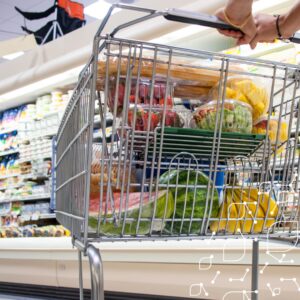
Best practices for manual ordering and production, and a summary of what we know about changing consumer behavior during the initial outbreak of the pandemic.
Here are some best practices that experts (including our own) are recommending, along with some fascinating statistics on consumer demand from around the world.
Survey Says: Out of stocks are the new norm
Progressive Grocer published the results of a survey on how COVID-19 was impacting grocers’ retail operations. Eighty percent of respondents said they have experienced a moderate to extreme increase in sales. This is leading to fulfillment issues and stores not being able to keep shelves stocked (70% said). The good news is that only a quarter of respondents said that the out-of-stock issues were related to supply chain challenges or supplier shortages.
We’re hearing from our partners that they are so overwhelmed that they are simply ordering whatever they can for core items. And for prepared foods, despite producing as much as possible, they are often sold out by 2 p.m.
For stores that are struggling to manage their manual ordering and production planning, or stores that have had to temporarily revert to manual processes, here are four best practices for new staff.
- Communicate – Have a daily huddle with store staff to discuss what is moving and what is not.
- Inventory Scanning – Do a quick scan of inventory positions and shrink out items that are past their due dates. Spot check at least three or four times a day, versus the standard one or two daily spot checks.
- Focus on Core Items – With shoppers stockpiling emergency items, focusing on filling holes in your core items. To help you determine what are your core items, we have created a separate worksheet. Limit your orders to these core items.
- Ordering – If no manager is available to review an order, default to ordering 100% of your standard quantity for that item. Focus on replenishing your core items and limit remaining SKUs. As the trend begins to wind down in the next two or three weeks and you see sales start to decline, reduce your orders by 50% for affected items.
You can download the manual production planner and weekly ordering template (Excel file) here. If you have any questions on how to use this tool, simply email us at [email protected].
We’re here to help
We just want to reiterate that we’re here to help in any way we can. We’d like to extend our expertise to any grocer who needs assistance currently. If you need help identifying core items, pulling together order or production guidelines or analyzing current sales trends, please let us know. Our hearts are with everyone during this difficult time.
Changing Consumer Behavior
At the start of the pandemic (week of March 8), fresh sales were up across the board, except for seafood which saw a noticeable decline.

GRAPH: CHANGES TO SUPERMARKET PERIMETER SALES DURING COVID-19
One American consumer survey found that the average household spent $170 USD to purchase essentials like cleaning supplies, food, water, medication, baby supplies, alcohol and entertainment in preparation for their self-isolation period. According to IRi data, stockpiling in the US began around March 1.

(PERCENT CHANGE DURING WEEK OF MARCH 8, COMPARED TO ONE YEAR AGO)
It’s interesting to take a step back and look at the numbers (especially on the much-discussed toilet paper hoarding). In our defense, the Brits were totally hoarding their TP too – actually, they were worse.
And some of the numbers are truly astonishing. Demand for hand sanitizer was up 450% and spray disinfectant, 390%.
We’ll be back next week with new numbers as the situation continues to unfold. Until then, please stay safe! If you want to connect with others in the industry, one of the magazines started a Coronavirus in the Food and Beverage Industry Facebook group that is worth checking out.





